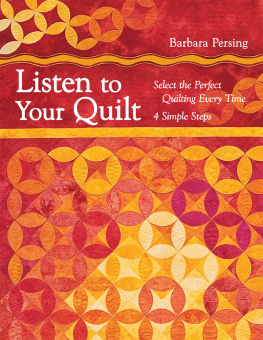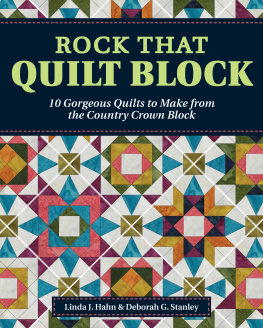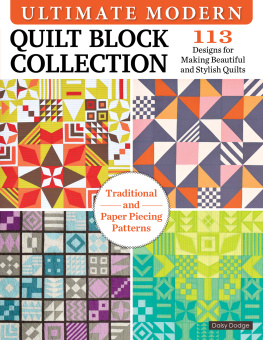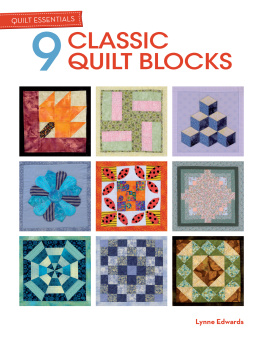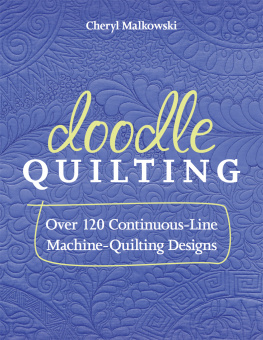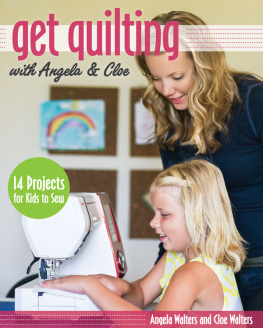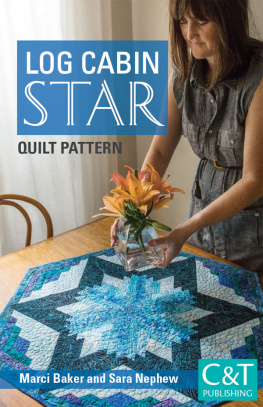

Text copyright 2013 by Ellen Luckett Baker.
Photographs copyright 2013 by Laura Malek.
All rights reserved. No part of this book may be reproduced in any form without written permission from the publisher.
ISBN 978-1-4521-2944-0
The Library of Congress has previously cataloged this title under ISBN 978-1-4521-1258-9
Designed by Vivien Sung
Photo styling by Ellen Luckett Baker
Pellon Wonder-Under is a registered trademark of Freudenberg Nonwovens Limited.
Velcro is a registered trademark of Velcro Industries B.V.
Chronicle Books LLC
680 Second Street
San Francisco, California 94107
www.chroniclebooks.com
CONTENTS
INTRODUCTION
C olor. Shape. Pattern. If you are interested in these elements of design, you will love quilting. Its art for your bed or your wall.
But why stop there? In 1, 2, 3 Quilt, you will hone your patchwork and quilting skills as you learn to make all kinds of projects, from table runners to handbags, clothing, and accessories. This book shows you that you dont need to take on a daunting project like a full-size quilt to get started.
In my previous book, 1, 2, 3 Sew, I explored the basics of sewing. Here, I help you take your skills a step further by incorporating patchwork and quilted designs. Through the years, Ive followed the modern quilting movement and watched as new quilters have renewed this art form with fresh designs, bright colors, and a pared-down sensibility. In my blog at the Long Thread (thelongthread.com), Ive discovered a vibrant and welcoming community of quilters, so it seemed natural for me to tackle quilting next. The limitless possibilities of quilting will allow you to take your sewing to a new level.
Growing up in Alabama, I was frequently exposed to the art of quilting. I remember visiting the curb market, where I saw women selling their calico quilts and pillows in traditional styles. I spent most of my childhood with a hand-sewn wedding rings quilt on my bed. But it wasnt until college that it even occurred to me that a quilt could be modern. I read an article about Denyse Schmidt in Martha Stewart Living and felt a strong connection to the warmth and modernity of her work. And I was blown away by the quilts of Gees Bend, which illustrate how something wholly unique can emerge from necessity and creativity. Here I am almost twenty years later, combining modern style and folk art with my passion for sewing. With bold, graphic shapes and clean lines, a quilt can tell a story, become a compelling work of art, or simply provide warmth and comfort.
There are 24 projects in 1, 2, 3 Quilt, with each project increasing in difficulty as a chapter progresses. The chapters are arranged by shapethe essential design element of any quilt. By working with the basic shapessquares, rectangles, triangles, circles, hexagons, flowers, stars, and diamondsyou can create endless quilt designs. Ive included full-size templates so youll have all the patterns you need to make the projects just as you see them here. After youve worked through the different shapes, you will understand the fundamentals of quilting and hopefully feel empowered to design your own quilts.
This book also teaches you a set of basic techniques that youll need to begin quilting (or to build on your current skills). There are how-to sections sprinkled throughout to help you shape up your skills as you work through the book. Each chapter culminates in a full-size quilt project, allowing you to apply your new skills with quilting shapes to a larger-scale project. Youll learn how to bind a quilt, use paper-piecing techniques, sew appliqus, and make patchwork quickly with some quilters shortcuts. Youll also learn basic sewing construction skills like how to install a zipper and tips for making a softie toy. As you master the different techniques, youll make a skirt, a handbag, pillows, coasters, and much more. Once youve made the projects in this book, youll be armed with the skills and confidence to create your own designs.
Lets shape up your skills!

THE PARTS OF A QUILT
I f you are new to quilting, heres a diagram illustrating the basic elements of a quilt. The quilt top is your main design element; its often sewn together in a patchwork fashion, or its made of one large piece (or a few large pieces) of fabric, creating whats known as a whole-cloth quilt. The batting is the center, cushioned layer that provides padding and warmth. The quilt back, or backing, can be made of patchwork, fabric scraps, or wide strips of the same fabric. The quilt binding is made of joined strips of fabric and is sewn to the front of the quilt, then wrapped around the edges of the three layers and machine sewn or hand stitched to the quilt back, enclosing the raw edges and holding together the layers of the quilt.

ESSENTIAL TOOLS
ROTARY CUTTER AND MAT The rotary cutter and self-healing cutting mat are essential tools in quilting because they significantly speed up the cutting process. The rotary cutter is similar to a pizza slicer and cuts cleanly and precisely, but must be used with care because it is very sharp. Always cut away from yourself when using this tool. The self-healing cutting mat has grid lines printed on it for simple measuring, and it is available in many sizesthe bigger, the better.
RULERS There are many sizes of clear acrylic rulers with gridded measurements available to help quilters get just the right size and shape. I recommend a 6-in-/15-cm-wide yardstick/metric ruler and a quilters square ruler, around 6 in/16.5 cm square.
MACHINE TOOLS You can make a quilt of any size with a regular sewing machine if you have patience and the right tools. For machine piecing, a -in/6-mm presser foot helps achieve accuracy on every seam. For top quilting, a walking foot, also known as an even-feed foot, is essential because it helps evenly feed the top and bottom fabrics simultaneously through the machine without puckering the material. For free-motion quilting, use a free-motion or darning foot, which allows you to move the quilt in any direction as you sew.
SCISSORS There are many different types of scissors for quilting. Before you start, make sure you have small scissors or thread snips handy by your sewing machine or by your side when you are hand sewing. Youll also want large dressmakers shears for cutting fabric, and inexpensive craft scissors for cutting paper patterns. Once you have more quilting experience, you may want to invest in embroidery scissors and appliqu scissors as well.
MARKING TOOLS To mark your fabrics, I recommend white and colored chalk pencils as well as disappearing ink fabric markers. Some of these markers make marks that disappear over time, while others are water soluble. Try several types of marking tools to see which you like best.
SEAM RIPPER
Next page

